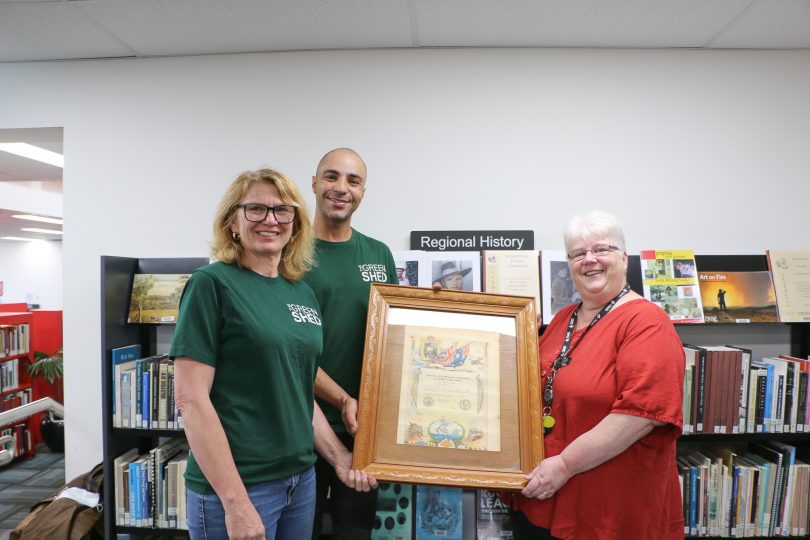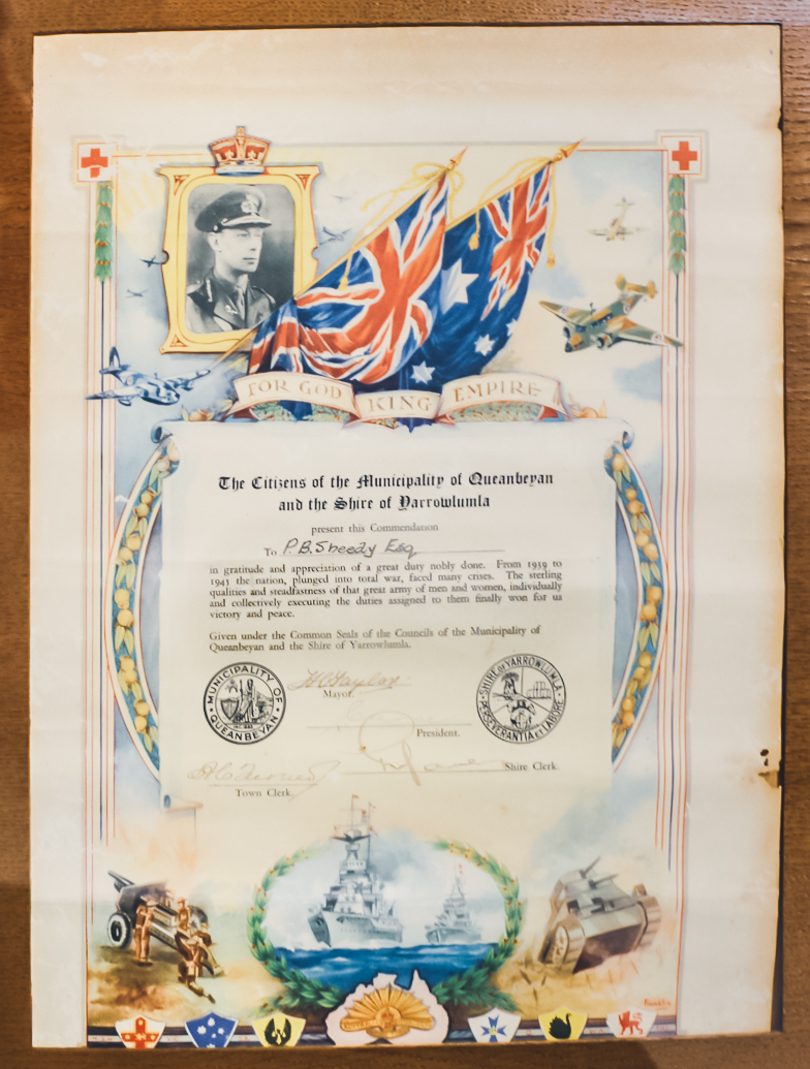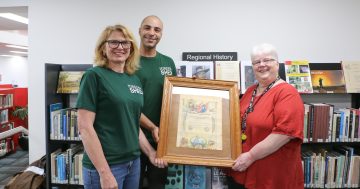
Sandie Parkes and Adam Charif from The Green Shed present Bert Sheedy’s certificate to Queanbeyan-Palerang Council’s local history librarian Brigid Whitbread. Photo: Queanbeyan-Palerang Regional Council.
Brigid Whitbread has no idea how a historic Queanbeyan document landed at Canberra’s Green Shed – she’s just immensely grateful it didn’t end up as landfill.
The document is a World War II certificate presented to Bert Sheedy, one of Queanbeyan’s leading historians. His writings form the cornerstone of the city’s local history collection, which ranges from books, Moneroo to Monaro: history of Monaro Street, 1830s-1995 and Queanbeyan, to his work on the three volumes of Queanbeyan: Pioneer Cemeteries, Burial and Index.
He also recorded a number of oral histories about Queanbeyan which are kept in the National Library of Australia.
Such is the value of Sheedy’s work that Brigid Whitbread, Queanbeyan-Palerang Regional Council’s local history librarian, literally “screamed for joy” when she saw what Sandie Parkes from the Green Shed had not only saved from landfill but donated to the Council’s collection.
“Bert’s family had donated filing cabinets full of local and family history, so receiving this document is worth its weight in gold,” Brigid said.
“He was a great advocate for Queanbeyan,” she said. “His writings are the foundation for our own local history collection here.”
Such certificates were presented to personnel who served in World War II by the Councils of the Municipality of Queanbeyan and the Shire of Yarrowlumla.
Bert Sheedy served with the 3rd Australian Infantry Battalion and the 7th Australian Machine Gun Battalion AIF in New Guinea.
He was awarded the British Empire medal in 1972 for his contribution to local history.
Brigid said usually such documents would go to the city’s museum, but given Bert’s connection to local history, the framed certificate would stay with the library’s local history collection.
“That’s usually my demarcation line – I keep the documents. But with this, I just couldn’t part with it,” she said. “It is such an important part of our local history collection.
“It is in remarkably good condition considering its age … there’s only just a little bit of foxing. But we plan to get it stabilised.”
The certificate will also be remounted in its frame to ensure it lasts for future generations to see it.

This certificate, to mark Bert Sheedy’s World War II service, was saved from landfill by the Green Shed and presented to Queanbeyan-Palerang Regional Council’s local history collection. Photo: Supplied.
Brigid said the connection formed with Sandie and the Green Shed was invaluable to the library specifically, and local history in general.
“We are so grateful she took the trouble to pass this on to us,” she said.
Brigid said in today’s world, people seemed to have more of a sense of urgency when it came to getting rid of “stuff”.
“Like when a person dies, for example, something that may be important to them, not necessarily in terms of monetary value, but what is the best plan for it, where should they pass it on to? We don’t want these things to end up in landfill.
“It only takes one generation to lose a story.
“Someone like Bert is a good example. When I started researching him, I found it quite tricky to find much information at all. It became clear that he wasn’t the sort of fellow who liked to blow his own trumpet.”
But she did find out a few interesting facts. “Turns out his family has been in the region since the mid-1800s. Apparently, he was born under the wagon his family was travelling in taking sheep to the Sydney Show.”
It’s not the first time Sandie from the Green Shed has recognised the worth of an item and ensured it found its rightful home.
Last year, she uncovered an 1885 bank ledger, complete with names still recognised in Queanbeyan today, like John Gale, founder of The Queanbeyan Age newspaper.
“It is in amazing condition,” Brigid said. “We’ve determined it’s a Bank of NSW ledger. Interestingly, at the top of each page of the ledger is the person’s credit limit. In 1885, the Queanbeyan Council was there, but as it was in its first year of operation, it did not have a big limit.”
Bert died in 2000, but thanks to the Queanbeyan Library’s local history collection, his story lives on.
Original Article published by Sally Hopman on Riotact.








